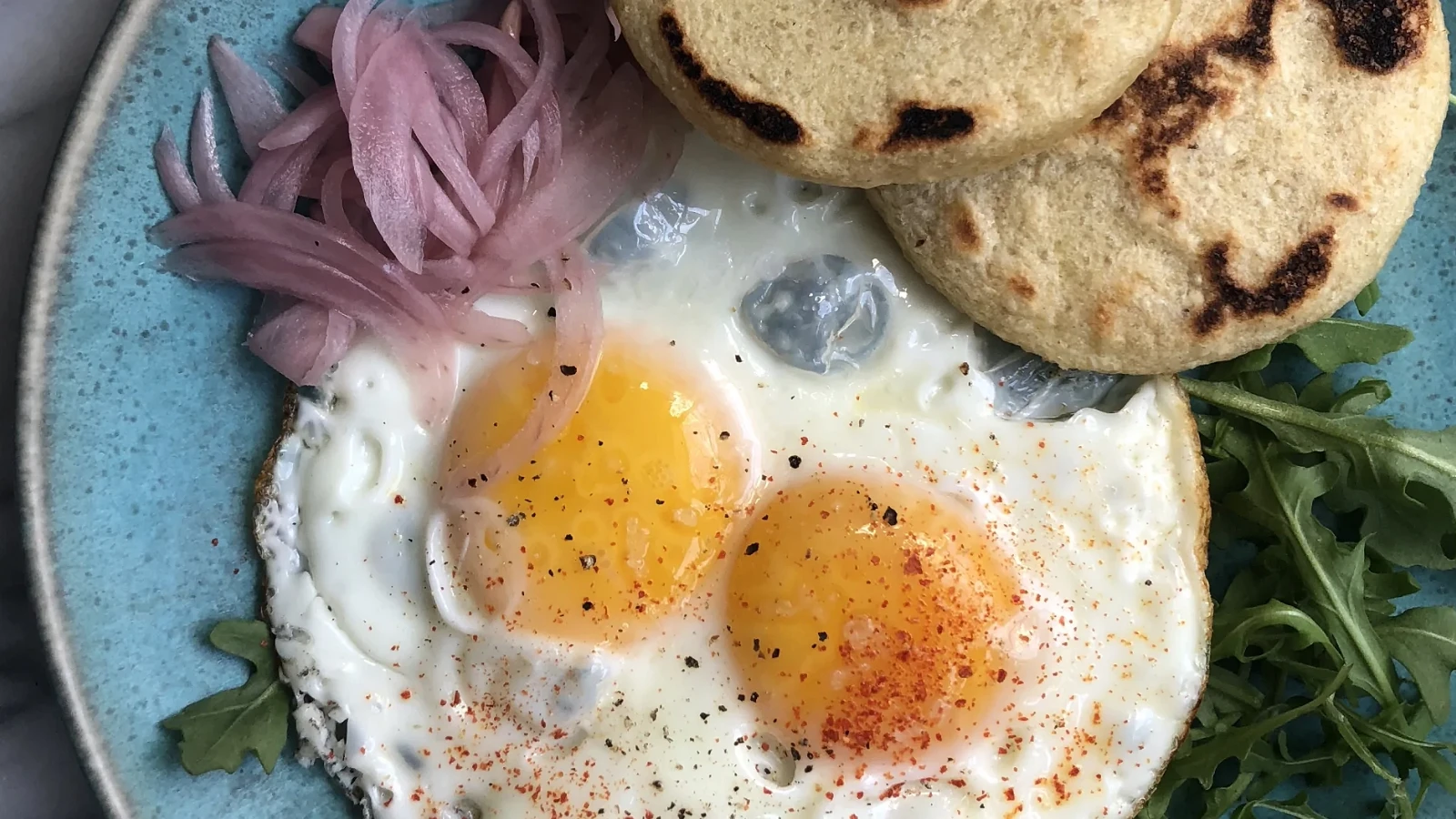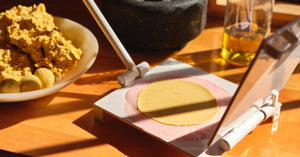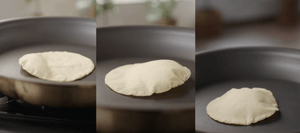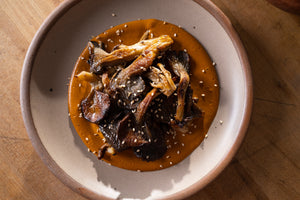Arepas with Mercedes Golip
Arepas with Mercedes Golip
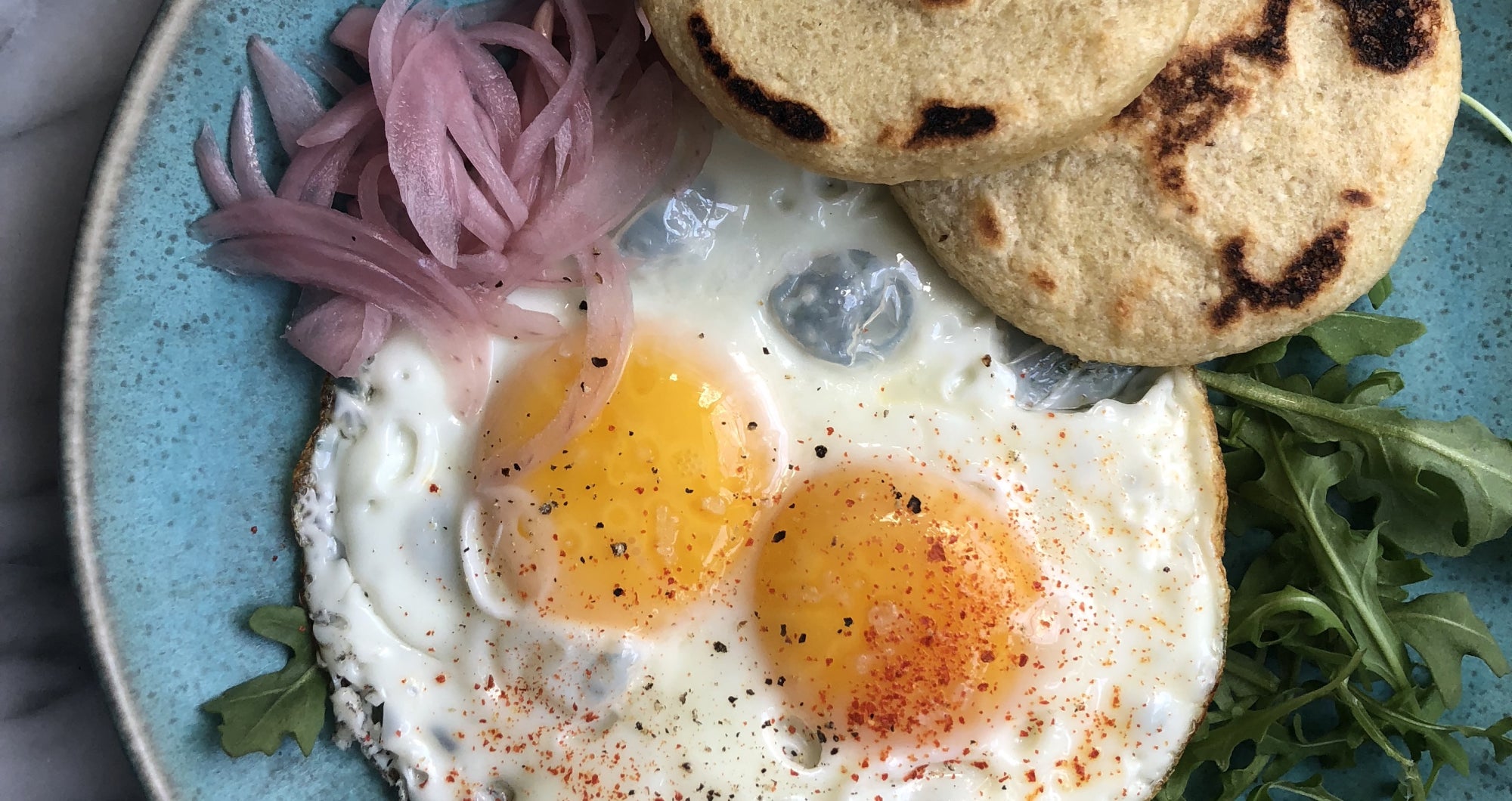
September 8, 2021
For this edition of Masa Shapes, we've invited our friend and arepa expert, Mercedes Golip, to guide us on this Venezuelan staple.
For a quick tutorial on how to make an arepa, watch our YouTube video below. To learn more about Mercedes, her favorite arepa application, and a brief history of this masa shape, scroll down to read our interview.
Mercedes Golip is a cook, educator, creative and farmer based in New York City. She first caught our attention through her Instagram account @iambananista, where she often documents her research of creating arepas from homemade nixtamal. For those who think of masa as a purely Mexican or Central American phenomenon, her thoughtful content is an engaging reminder that the foodway and culture of masa transcends any one place, people, or time--it is a connective tissue across Latin America and many parts of the world! In addition to serving up a proper Arepa 101 edition of Masa Shapes, Mercedes shared with us a bit more about her journey from Venezuela to Astoria to Swan Lake, her favorite way of enjoying arepas, and just what exactly the difference is between a hallaca and a tamal.
Tell us a little bit about your background--where are you from originally? Where do you live now? What is your day job?
I am originally from Venezuela. I moved to the US 16 years ago in my early 20s. I live now in Astoria, Queens, but I started my journey in Miami where I have family and a bunch of friends. As for my day job, I am a project manager in advertising.
On the surface, there might not be much of a connection between cooking and project management (hah!), but in my case, I think there is a lot. For example, I tend to be extremely organized and that shows in how I prep in the kitchen!
But, because my job is not as hands on, this was an important outlet I found where I could do something with my hands, put my creativity to work and have something of my own that builds upon my identity and where I come from. It was something that happened very organically.
How did you get into cooking?
I have always cooked. When I was little, all I wanted to do was follow recipes from any books I could get my hands on. My mom was extremely organized in her kitchen, so I wasn’t always allowed there--but I would usually do it anyways!
When I moved to Miami, cooking was a way to make extra money. I found my niche making hallacas, Venezuelan tamales, in December and selling them to my friends, for example, but it was very seasonal and occasion based. I think it ultimately found its way to grow when I got to New York.
How did your move to New York affect your connection to Venezuelan cooking and identity?
I really started exploring a lot more when I moved to New York. Before moving here, I’d never experienced the seasons! All of a sudden, Fall would arrive and we had all of these pumpkins around, for example. The weather was changing and making us want to eat different things based on what was available and tasting best. Having grown up eating tomatoes all year round, I soon learned that there is no point in eating tomatoes in January in New York because they taste awful! So I instead chose to approach my consumption and cooking around what the seasons had to offer.
Slowly but surely, I started incorporating that element of seasonality into my cooking in a personal way, with foods I grew up with. And, before I knew it, a lot of other things began to spark for me around identity, my appreciation for the diversity of cultures living in the US and how they all build a sense of shared community here. I was influenced by so much and began to blend this experience in my cooking; I became a sponge for all that was happening around me.
What inspired your deep dive into Venezuelan cooking?
Around 2016, I was volunteering a lot at The Brooklyn Kitchen, a local culinary education and retail space in Brooklyn, and noticed that there weren’t any classes at all that focused on Latin food. There were butchering classes, pasta classes and several classes on various global cuisines, but nothing Latin focused. In my mind, these were also cuisines worth exploring and teaching, and so I was like, “OK, I’m going to teach a Venezuelan class!”
At the time, I would teach arepa-making classes using Harina P.A.N. (which stands for Productos Alimenticios Nacionales), the arepa equivalent of masa harina, which I’d always used my whole life. In my head, this was the traditional way to prepare arepas, and so I used it every time. Then, one day, someone asked me during a class, “If you don’t have this flour, how can one make this masa from scratch?”
That’s when I went totally blank...I wanted to die! Sure, I’d read about it, but I had never connected with the process and didn’t know how to respond. I had never even seen corn for making masa in real life! That question was mind blowing. I thought to myself, ‘I cannot be the arepa teacher that doesn’t know how to make arepas from scratch!’ This was the moment that things began to pivot for me. I had cooked my whole life but I had never done the process myself. This is when I started to do a deep dive into the traditional process of making masa.
How is masa for traditional arepas made?
As far as arepas go, there are two kinds: arepas piladas (with an “i”) and arepas peladas (with an “e”).
The most common kind of arepas we find today are arepas piladas. To make masa for arepas piladas, dry corn (a type commonly called cariaco, which closely resembles the soft, floury cacahuazintle landrace from Mexico) is pounded until its skins begin to separate from the kernels. The skins are then mechanically removed and discarded before the broken kernels are cooked in water, strained, and ground into a dough. This is the same process that is used to make Harina P.A.N., or masa arepa, the dehydrated version of this masa. As far as flavor goes, the final taste is pretty neutral, even bland, compared to arepas peladas.
Arepas peladas are made from nixtamal, or corn that has been cooked with a basic element that helps remove the skin. Instead of cal, however, ashes are more commonly used as the basic element in the preparation of nixtamal for arepas peladas. Traditionally, ashes are taken from the hearth under the comal (what we call in Venezuela, a budare), which really gives the masa a smokey, toasty flavor.
There are many states in Venezuela where communities use the process of nixtamalization to make their arepas. This process also happens in Colombia. It’s a food history we both share.
Where do arepas originally come from? Venezuela or Colombia?
No one knows for sure! Cases can be made for either Colombia or Venezuela having first created the arepa. Both countries have a strong cultural connection with the cornbread known as arepa and both cultures still practice the production of both arepas piladas and peladas.
However, linguist experts have specifically attributed the word “arepa” to two different sources in Venezuela: The first is the Cumanagoto people, a tribe from the eastern coast of Venezuela. This tribe coined the word "erepa," a corn bread made on the "aripo" (what today we know as budare/comal). The second is the Timotocuicas people, a tribe from the Andean region of Venezuela, in close proximity with Colombia. For some, they are also credited with having invented the arepa.
Of course, it’s also easy to imagine corn and nixtamal traveling south through Mesoamerica, landing in Colombia before ultimately arriving in Venezuela. We just don’t know for sure.
What is the difference between an arepa and a gordita?
They are sometimes, though not always, the same exact thing! Arepas peladas, made from nixtamal, are essentially the same thing as a gordita, which is also traditionally made from nixtamal--the only difference is their names and the culture they come from. Both are, of course, stuffed, they may be made with lard or fried. The fillings will definitely vary across cultures, but the shape is the same!
The same thing happens with hallacas and tamales. It’s just the proper name in two different cultures. If you look at the meaning of the word hallaca, it means “wrapped.” And that’s exactly what the meaning of tamal is, when translated from Nahuatl. At the end of the day, each culture has their own names for similar, if not the same, things.
What is Harina P.A.N.?
When someone says “masa” in Venezuela, they are thinking of masa made with Harina PAN.
Harina P.A.N., or masa arepa, was invented and patented in the 60s--it’s like the Maseca of Venezuela. Masa arepa is made from corn whose skins have been mechanically removed (aka maíz pilado), cooked in water, ground, and then dehydrated. Unlike masa for arepas peladas, there is no cal or basic element involved in its preparation, just water.
So, what is the difference between masa harina and masa arepa?
Masa harina is made from nixtamal (aka maíz pelado), whereas masa arepa is made from maíz pilado, corn that has had its skins mechanically removed, cooked in water (no cal) and ground.
In your deep arepa dive, what has been the most surprising revelation or fact you've learned?
One of the things that was very impressive to me was the amount of flavor you can get out of real corn for masa. I cannot believe that for a long time, I was trying to use organic wheat flours, dairy straight from the producers...all of these ingredients straight from the source, but then I would completely overlook the product that I was using most on a daily basis: masa. Just because it had a logo that I loved and it was very familiar to me, I didn’t think about where it came from or how it was produced. Even being from an advertising background, I was completely sure that Harina P.A.N. was the only option for me. And why would you do differently? It’s all over the world.
But how is this really authentic, if this is made all around the world, not just in Venezuela? How is it really authentic if it’s using corn from each country in which it's made? How is it really authentic if it’s using GMO corn? I realized I had to experience the tradition for myself.
To be sure, I recognize that I have a privilege to have access to these ingredients and to have the time to ask myself these questions, to explore how to make nixtamal. I have the opportunity to travel, I have access to restaurants, I can take time off if I want to stage at a restaurant. That’s why I am very open with what I have learned. It’s my way of giving back in return for my education. I understand that a lot of people cannot invest the time and money in these premium ingredients, but hopefully all of these conversations will be something that will help this market grow, will be beneficial for the producers, beneficial for all.
You just bought a farm! Tell us about your upcoming plans for it and how we can enjoy your work in real time.
I would like to use the farm for a little educational agri-tourism spot. In my vision, I had a food forest planned for it--like a milpa, which, in Venezuela, would be called a conuco--it’s basically a diversity of agriculture contained in a single field. I want to find the things that would be most adaptable to the place, corn included. It’s in Swan Lake, NY, a mile away from the original site of Woodstock, which I think is going to bring a funky energy to the space.
What is your favorite filling or way to enjoy an arepa?
I love arepas for breakfast. Anything with eggs will make me very happy. I have a thing for huevos pericos. It’s just scrambled eggs with onions and tomatoes. That’s my jam. With cheese and butter.
